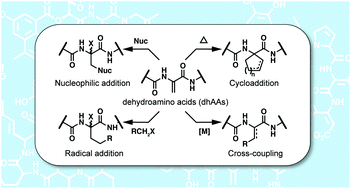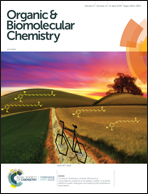Dehydroamino acids: chemical multi-tools for late-stage diversification
Abstract
α,β-Dehydroamino acids (dhAAs) are noncanonical amino acids that are found in a wide array of natural products and can be easily installed into peptides and proteins. dhAAs exhibit remarkable synthetic flexibility, readily undergoing a number of reactions, such as polar and single-electron additions, transition metal catalyzed cross-couplings, and cycloadditions. Because of the relatively mild conditions required for many of these reactions, dhAAs are increasingly being used as orthogonal chemical handles for late-stage modification of biomolecules. Still, only a fraction of the chemical reactivity of dhAAs has been exploited in such biorthogonal applications. Herein, we provide an overview of the broad spectrum of chemical reactivity of dhAAs, with special emphasis on recent efforts to adapt such transformations for biomolecules such as natural products, peptides, and proteins. We also discuss examples of enzymes from natural product biosynthetic pathways that have been found to catalyze many similar reactions; these enzymes provide mild, regio- and stereoselective, biocatalytic alternatives for future development. We anticipate that the continued investigation of the innate reactivity of dhAAs will furnish a diverse portfolio dhAA-based chemistries for use in chemical biology and drug discovery.

- This article is part of the themed collection: Biosynthesis


 Please wait while we load your content...
Please wait while we load your content...